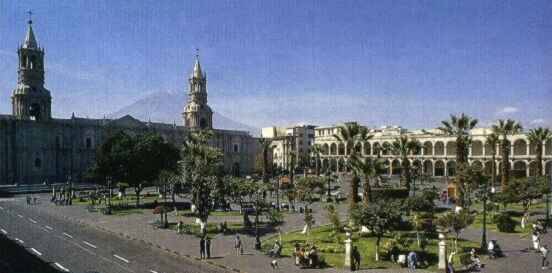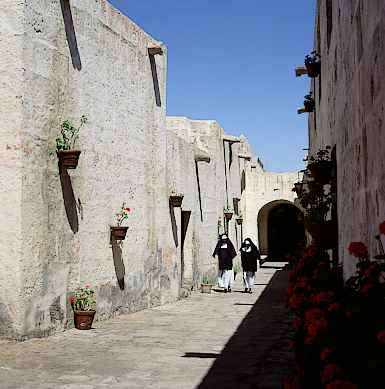| We leave from Nazca to
Arequipa, located at 500 Km. south from Nazca ( the travel takes
seven hours).
Situated 2360 m. Above sea-level and 70 km. from
the sea as the crow files. Arequipa is a beautiful city with an
original personality that we can see in the design of local houses
and churches made of a local material called "sillar"
or volcanic material which was disgorged by Chachani at the end
of the Tertiary period and during the beginning of the Quaternary.

Tour of the city Principal monuments :
The cathedral, Is a modern building rebuilt after
two succesive disasters, the fire of 1844, which destroyed the old
building in 1656, and not long after it had been rebuilt. The earthquake
of 1868 that again reduced it to rubble. Its faces to the Plaza
making it seem unusually long and low in proportion to the rest
of the buildings. And other one is the Monastery of Santa Catalina.
Is in Fact a small town (with an area of 20,426 m2) retaining the
typical features of the 16th and 17th centuries,
its little streets and picturesque comers are a paradise for photographers.
|
|
| We Leave from Paracas
to Nazca, zone located at 200 Km south of Paracas Peninsula, two
hours by Car, here will can see the misterious Nazca Lines. To reach
this place you can choose an airplane or walk. Also there is an
observatory where you can watch the Nazca lines.

Are the figures and lines of Nazca strange drawings,
lines and figures traced by an ancient and unknowwn people? They
are mentioned by Cieze de Le�n in 1548 (he calls them "sings
pointing out the way" to travellers). They were first discovered
and mentioned in modern times by Toribio Mejia, in 1927 studied
from the air By Pul Kosok, in 1941, and again by Hans Horkheimer
in greater detail in 1946. (an aerial view is much easier and complete
than a ground survey) they were subsequently studied for 40 years
by the german scientist Maria Reiche, who has published several
works on the subject.

In Pampa Colorada where these lines are to be found
is a story desert (similar to the hamadas of the Sahara) into which
the most varied types of figures have been cut, a bird with a wing-span
of 100 m; an enormous monkey; and large numbers of great triangles
and parallel lines. The motive for putting them there is unknown.
Paul Kosok related them to astronomy, but the mistery continues,
in spire of Miss Reiche`s long investigations � Another interesting
feature of the old Nazca Culture are the mentioned underground channels
in the valleys of the river "Tierras Blancas"( white lands)
in Nazca and the Quebrada (Ravine) de las Trancas"; they are
similar to the fogarras of north Africa and the Kanats of Persia |
|

